Australia’s treatment of asylum seekers has been an ongoing controversy for some time. Every year, around 1 million new people seek asylum worldwide. By mid-2021 4.4 million refugees were fleeing their countries. People flee their nations for a variety of reasons. These include war, violence, hunger, and poverty. People also seek to escape due to their religious or political beliefs, or sexual or gender orientation.
Climate change directly affects refugee numbers. We know that climate change causes increased extreme weather events. Drought, flood, and rising sea levels increase competition for scarce resources. This can also escalate into wars. All these things create humanitarian crises. Thus, climate change increases the number of people seeking asylum.
Claiming asylum is not illegal in Australia, nor anywhere else in the world. Rather, asylum is a basic human right. The UN regards justice for displaced persons as a key part of a sustainable global community.
So, how is Australia’s asylum seeker policy likely to change over the next few years? This article explores the evolution of that policy and the pressures on it to change.
An asylum seeker is “someone whose request for sanctuary has yet to be processed”.
the United Nations High Commision for Refugees (UNHCR)
Do Asylum Seekers Have Rights?
Many asylum seekers arrive by air, and later seek a valid visa under an asylum claim. In fact, only a small proportion of asylum seekers currently arrive to Australia by boat. Admittedly, there has been a slight rise in boat numbers recently. Australian law classifies those who do arrive illegally by sea as “unlawful non-citizens”.

Nevertheless, the Australian government is a signatory to various international treaties. These treaties protect the human rights of asylum seekers whilst under Australian authority.
Treaties Australia has signed that protect asylum seekers:
- International Covenant on Civil and Political Rights
- Convention Against Torture
- Convention on the Rights of the Child
The treaties also prevent Australia from sending people back if they would be in danger. Further, Australia supports the UN’s Sustainable Development Goals (SDG’s). 193 countries (including Australia) adopted the SDGs in 2015. SDG16 calls for “peaceful and inclusive societies.” These societies must protect children from “abuse, exploitation and violence.” Thus, to meet these goals, Australia must provide safe haven.
What is Australia’s Policy on Asylum Seekers?
Australia has been accepting asylum seekers since 1945. Under its laws, the Australian border defence team intercepts asylum seekers at sea. They are then held in detention centres until a valid visa is granted (Migration Act, 1958).
The Australian government first introduced offshore detention program, the Pacific Solution, in 2001. Since then, they sent all refugees arriving by boat to offshore camps in Nauru and Papua New Guinea (PNG). Different governments have repealed or revived the policy in the years since.
In 2012, the Australian government reintroduced the Pacific Solution. They relabelled it as a new offshore program, the Pacific Solution Mark II. This revived program was in response to a large rise in boat arrivals.
The stated intent of the Pacific Solution Mark II was to prevent any advantage for refugees arriving by boat. Media surrounding the issue referred to “boat people” as “queue jumpers“. These refugees were to receive no advantage over those who were making their application from overseas. As such, offshore processing centres resumed on Manus Island (PNG) and Nauru Island.
From 2013, the Australian government began ‘Operation Sovereign Borders’. The operation denies all so-called ‘illegal arrivals’ any chance of resettlement in Australia. Sovereign Borders placed the operation of Australia’s asylum seeker program under military control. Since then, when the government does grant refugee status, it resettles them in a third country. At best, the government grants such refugees only temporary protection in Australia.
However, in 2014, the PNG Supreme Court ruled that the Manus Island detention centre was unconstitutional and illegal. This effectively ended the detention deal between Australia and PNG. Offshore processing nonetheless continued on the island of Nauru. By April, 2021, there were 131 asylum seekers remaining in PNG, and 109 on Nauru.
The Crisis in Australia’s Detention Camps
Australia has failed to provide adequate care for asylum seekers. The many reports of violence, sexual and physical assaults, and mental illness in these detention camps prove it. Refugees die due to hunger strikes, riots and inadequate medical care. Detainees suffer high rates of suicide and self-harm.
Moreover, 13 people detained in Nauru and PNG have died directly from violence, suicide or lack of medical care. In 2017 Australia paid a AU$70 million settlement to over 1900 detainees who sued the government for assault during their detention.

The Australian Human Rights Commission observed these conditions during a series of inquiries. It made recommendations to the government to improve conditions. As yet, there is no evidence the government has implemented these recommendations.
What is there to fear from Asylum Seekers?
So, why are Australia’s asylum policies so strict? Primarily, the government wishes to avoid the financial burden of providing ongoing care to new arrivals. Another reason is that unauthorised migration directly affects the country’s population growth. The government claims rapid population growth would negatively impact the economy.

Furthermore, the government espouses safety concerns. They believe a weak border policy encourages many more asylum seekers to embark on risky journeys by sea.
The government also point to the fact that people arriving by boat do not generally have legal documents with them. They believe this may provide an avenue for terrorists or criminals to enter Australia. These fears have been largely debunked.
What now for Offshore Processing?
Offshore processing on Manus Island ends in 2021. So, what happens next in Australia’s detention policy?
From 2022, asylum seekers who wish to remain in PNG will be given permanent residency or citizenship. Others will have to transfer to a third country, or to the offshore processing centre in Nauru.
The Australian government signed a new agreement with Nauru on the future of offshore processing in 2021. To date, very little information about this agreement has been made public.
This does not address the government’s duty to protect the human rights of asylum seekers. There has to be proper oversight of Australia’s treatment of refugees to make sure the country is meeting its international obligations.
The UN’s Strategic Development Goal 16 (SDG 16) demands that countries ‘provide legal identity and equal access to justice for all’ by 2030.
Meanwhile, the UNHCR is actively encouraging governments to include asylum seekers in their national health and education systems.
The UN’s strategic goals are key drivers of global progress towards a sustainable society. The Thrive Project is an advocacy and knowledge resource that supports the pursuit of sustainability and prosperity for all. We want to instil the concept of ‘thrivability’ within the very fabric of society. Find out more about THRIVE at our website or sign up to the THRIVE newsletter.






















